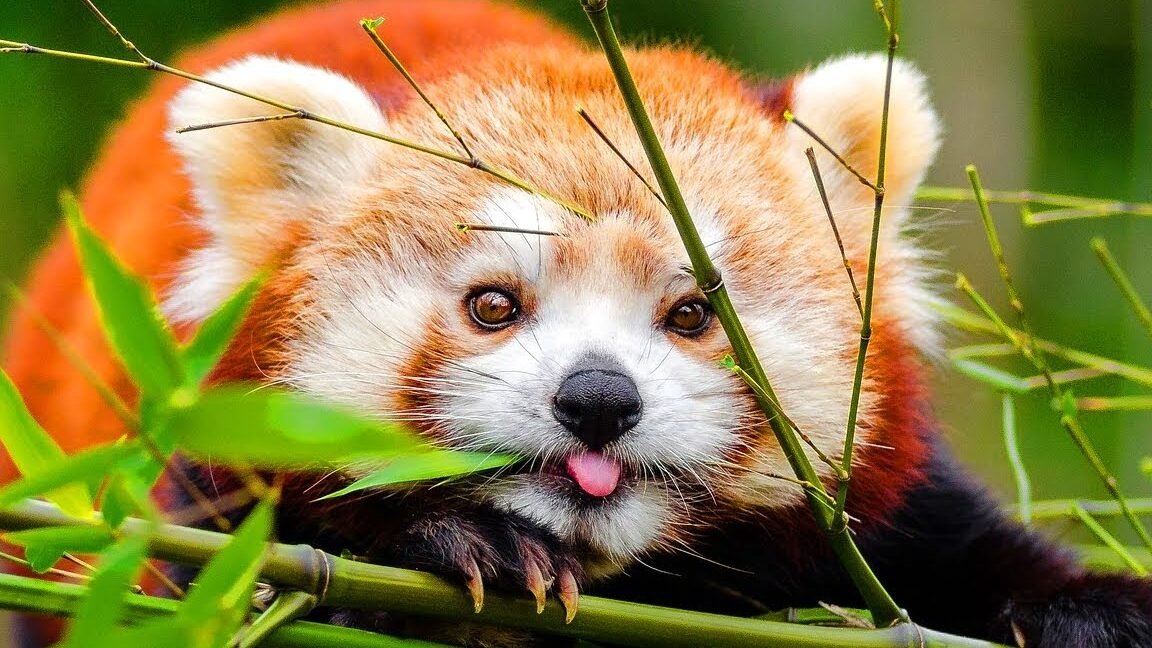Discover the enchanting world of red pandas, also known as lesser pandas or red raccoons. These charming creatures call the eastern Himalayas and southwestern China home, where they thrive in lush bamboo forests. With their captivating features and endearing presence, red pandas have captured the hearts of animal enthusiasts worldwide.
- Distinctive Traits
- Natural Habitat
- Lesser Pandas or Red Raccoons
- Physical Characteristics of Red Pandas
- Red Panda's Habitat and Distribution
- Diet and Feeding Habits of Red Pandas
- Behavior and Lifestyle of Red Pandas
- Conservation Status of Red Pandas
- Red Panda Conservation Efforts
- Fascinating Facts about Red Pandas
- Red Panda Conservation: A Call to Action
- Red Panda Conservation: How You Can Help
- Conclusion: Why Red Pandas are Worth Protecting
Distinctive Traits
- Red pandas are petite mammals, measuring between 20 to 26 inches (50-65 cm) in body length and sporting tails that range from 12 to 20 inches (30-50 cm).
- Their fur is luxuriously thick and soft, consisting of two layers: an outer coat that repels water and an inner layer that provides insulation.
- A defining characteristic of red pandas is their striking reddish-brown fur on their backs, which gives them their name. Additionally, they boast white markings on their face, chest, belly, legs, and tail.
- Their adorable round faces feature expressive eyes framed by white fur patches reminiscent of spectacles.
Natural Habitat
Red pandas predominantly inhabit temperate forests at high elevations ranging from 6,000 to 13,000 feet (1,800-4,000 meters). These delightful creatures can be spotted in countries such as Nepal, Bhutan, India, China, and Myanmar.
Lesser Pandas or Red Raccoons
The monikers "lesser panda" or "red raccoon" highlight certain physical resemblances shared by these species. Despite not being closely related genetically, both animals sport ringed tails akin to those found in raccoons.
Physical Characteristics of Red Pandas
Discover the enchanting physical traits of red pandas, also known as red raccoons or lesser pandas. Let's uncover the distinctive features that make these charming creatures stand out.
 Discover the Fascinating Connection Between Red Pandas and Raccoons
Discover the Fascinating Connection Between Red Pandas and Raccoons- Red pandas are petite compared to other bear family members, typically measuring between 20 to 26 inches (50 to 65 centimeters) in length from head to tail.
- Their bushy tails can extend up to an impressive 18 inches (45 centimeters).
- Adult red pandas usually weigh between 7 and 14 pounds (3 to 6 kilograms).
- The name "red panda" perfectly suits them due to their reddish-brown fur covering most of their bodies.
- Their bellies are often black or dark brown for effective camouflage from predators below.
- A standout feature of red pandas is their thick fur, ideal for surviving cold mountain climates.
- Resembling raccoons or foxes, red pandas boast distinct facial markings.
- Equipped with climbing prowess, red pandas have specialized paws with semi-retractable claws for gripping branches securely.
Red Panda's Habitat and Distribution
Red pandas, also known as red raccoons or lesser pandas, are native to the eastern Himalayas in regions such as Nepal, Bhutan, China, northern Myanmar, and India. These areas provide an ideal environment for red pandas due to their dense forests filled with bamboo understory.
- Red pandas thrive in high-altitude temperate forests.
- Bamboo makes up a significant portion of their diet (85-95%).
- Their habitat spans elevations between 6,000 to 12,000 feet (1,800 to 3,600 meters).
- Over time, red pandas have adapted well to their surroundings.
- Red pandas spend most of their time in trees where they feel safe from ground threats.
- While primarily arboreal creatures, red pandas come down from trees at night for feeding purposes.
Diet and Feeding Habits of Red Pandas
When it comes to red pandas, their diet is truly fascinating. These adorable creatures are known for their love of bamboo, but they also enjoy indulging in fruits, berries, leaves, and flowers. While primarily herbivorous, red pandas may occasionally snack on small insects or birds' eggs.
- Red pandas heavily rely on bamboo for sustenance.
- Despite being classified as carnivores taxonomically, red pandas lean towards a vegetarian diet.
- The availability of various food sources impacts the red panda's diet throughout the year.
- Red pandas have a sluggish metabolic rate due to their low-calorie bamboo-based diet.
- Red pandas showcase an intriguing behavior called "sitting-feeding."
- These charming creatures are predominantly nocturnal feeders.
- While juicy plants like bamboos provide most of their water intake requirements, red pandas may sip water directly from streams or puddles if needed.
Behavior and Lifestyle of Red Pandas
Delve into the captivating world of red pandas, also known as lesser pandas or red raccoons. These unique creatures exhibit a range of behaviors that set them apart from other animals in the wild.
- Red pandas are primarily nocturnal beings.
- They mark their territory using scent glands near their tail base.
- Witness the unique courtship ritual known as the "Firefox" stance.
- Red pandas reproduce once every two years or longer intervals.
Conservation Status of Red Pandas
Red pandas, also known as red raccoons or lesser pandas, are currently facing critical conservation challenges. These charming creatures have been classified as endangered on the International Union for Conservation of Nature (IUCN) Red List due to various threats to their survival.
 Discover the Fascinating Behavior of Red Pandas in the Wild
Discover the Fascinating Behavior of Red Pandas in the Wild- Habitat Loss: The expansion of human populations has led to the destruction of the forests where red pandas reside at an alarming rate.
- Poaching: In the past, red pandas were hunted for their valuable fur in illegal wildlife trade markets.
- Climate Change: The impact of climate change poses a significant threat to red panda conservation efforts.
Red Panda Conservation Efforts
Red pandas, also known as red raccoons or lesser pandas, are currently facing critical conservation challenges. These charming creatures have been classified as endangered on the International Union for Conservation of Nature (IUCN) Red List due to various threats to their survival.
- Protected Areas Establishment: Creating protected areas like national parks and wildlife reserves plays a pivotal role in shielding critical habitats where red pandas can flourish undisturbed.
- Community Engagement: Involving local communities in conservation endeavors fosters a sense of stewardship towards safeguarding red panda habitats.
- Research Advancements: Scientific research focusing on aspects such as behavior, ecology, and genetics provides invaluable insights into understanding the needs of red pandas while aiding in formulating effective conservation strategies.
- Awareness & Education: Raising awareness about the importance of conserving these unique creatures among both local communities and global audiences is vital.
- International Cooperation: Collaboration between governments, NGOs, and international organizations is crucial to address the transboundary nature of red panda conservation.
Fascinating Facts about Red Pandas
Red pandas, also known as red raccoons or lesser pandas, are captivating creatures that never fail to charm. Here are some intriguing and little-known facts about these delightful animals:
- Red pandas boast a vibrant reddish-brown fur, distinctive white face markings, and fluffy tails that aid in balancing while navigating trees.
- These adorable mammals primarily feast on bamboo leaves and shoots, with their diet consisting of nearly 90% bamboo!
- Red pandas spend the majority of their time in trees for safety from predators and easy access to their beloved bamboo.
- Unlike other panda species, red pandas prefer solitude and mark their territories using scent glands near the base of their tail.
- Active mainly at night, red pandas forage for food and engage in social interactions within their territory under the cover of darkness.
- Red pandas showcase a unique behavior called the "Firefox" stance, standing upright on hind legs with front paws raised high.
- Female red pandas reproduce only once every two years or longer intervals due to low fertility rates and an extended gestation period.
- Regrettably, red pandas are currently listed as endangered due to habitat loss and illegal hunting.
Red Panda Conservation: A Call to Action
Red pandas, also known as red raccoons or lesser pandas, are captivating creatures that warrant our unwavering attention and protection. Currently classified as "vulnerable" by the International Union for Conservation of Nature (IUCN), these charming animals face a looming threat of extinction in the wild if immediate action is not taken.
- Habitat Loss: The foremost peril to red pandas stems from habitat loss caused by deforestation and human encroachment.
- Illegal Wildlife Trade: Poachers frequently target red pandas for their exquisite fur or sell them as exotic pets.
- Climate Change Impact: The repercussions of climate change on the Himalayan region directly impact suitable habitats and disrupt food sources crucial for sustaining red panda populations.
Red Panda Conservation: How You Can Help
If you harbor a deep-seated passion for preventing these endearing creatures from vanishing forever, there are numerous avenues through which you can contribute:
 Discover the Best Red Panda Prices and Adoption Options
Discover the Best Red Panda Prices and Adoption Options- Support Conservation Organizations: Extend your support to reputable organizations dedicated to conserving endangered species like the Red Panda Network or WWF's Adopt a Species program tailored specifically towards protecting red pandas.
- Raise Awareness: Educate others about the significance of conserving red pandas and shed light on the perils they confront.
- Embrace Sustainability Practices: Incorporate sustainable choices into your daily routine by opting for eco-friendly products and reducing your carbon footprint wherever possible.
Conclusion: Why Red Pandas are Worth Protecting
Red pandas, also known as red raccoons or lesser pandas, are captivating creatures that never fail to charm. Here are some intriguing and little-known facts about these delightful animals:
- Red pandas boast a vibrant reddish-brown fur, distinctive white face markings, and fluffy tails that aid in balancing while navigating trees.
- These adorable mammals primarily feast on bamboo leaves and shoots, with their diet consisting of nearly 90% bamboo!
- Red pandas spend the majority of their time in trees for safety from predators and easy access to their beloved bamboo.
- Unlike other panda species, red pandas prefer solitude and mark their territories using scent glands near the base of their tail.
- Active mainly at night, red pandas forage for food and engage in social interactions within their territory under the cover of darkness.
- Red pandas showcase a unique behavior called the "Firefox" stance, standing upright on hind legs with front paws raised high.
- Female red pandas reproduce only once every two years or longer intervals due to low fertility rates and an extended gestation period.
- Regrettably, red pandas are currently listed as endangered due to habitat loss and illegal hunting.
In essence, red pandas hold a special place among wildlife enthusiasts with their striking appearance, bamboo-based diet, treetop lifestyle, solitary tendencies, nocturnal habits, "Firefox" stance behavior, sparse reproduction rate, and endangered status. Let's unite in protecting their natural habitats and securing a future where these endearing creatures thrive abundantly.
If you want to know other articles similar to Introduction to Red Pandas you can visit the Red Panda category.

